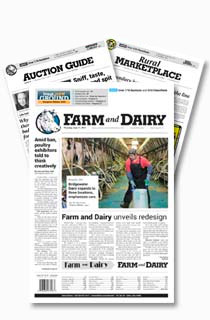
Over the last 30 years, the U.S. dairy industry has been transformed from a domestic supplier that was not even noticeable on the global market to a major player in the global dairy trade.
Today, even as year-over-year domestic dairy demand continues to grow to the highest level in six decades, approximately one in six tanker loads of milk are exported. The top 10 destinations for U.S. dairy exports are Mexico, Canada, China, Japan, South Korea, Philippines, Indonesia, Australia, European Union and Dominican Republic. Mexico is the top destination for U.S. dairy exports, with one in every 4 pounds of dairy products leaving the U.S. bound for there.
Mexico
Since 2011, domestic production in Mexico has grown by 1.8% annually. Mexico now produces 224 pounds per capita domestically, while the U.S. produces 677 pounds per capita. Of Mexico’s domestic production, 48% of it goes into fluid milk. Mexican citizens currently only drink 107 pounds of milk per year, while Americans drink 135 pounds indicating room for continued fluid milk growth.
Since 2011, Mexico’s per capita consumption has increased by 20% or 50 pounds of milk equivalent. Mexico’s dairy production deficit is about 30% annually; of this deficit, U.S. exports cover approximately 80% of these needs, mostly in the form of milk powders, cheese and whey proteins.
In 2023, U.S. dairy exports to Mexico totaled 1.38 billion pounds of milk solids. In 2023, Mexico purchased 51.5% of all U.S. nonfat dry milk and skim milk exports.
Cheese is also a major export to Mexico, with 327 billion pounds being exported in 2023. By the end of October 2024, this amount had already been surpassed, with 37.4% of U.S. cheese exports going to Mexico.
As Mexico’s middle class continues to grow, so does the country’s appetite for dairy products. The total dairy export value to Mexico in 2024 was $2.47 billion. The average Mexican citizen only consumes 45% of the amount of dairy products that the average American consumes. Mexico purchases approximately 4.5% of the United States milk production in the form of both dairy products and ingredients.
Canada
In 2024, Canada was the second-largest export destination for U.S. dairy products. In 1999, the U.S. had a negative dairy trade balance with Canada, but today it has grown to a positive trade balance of $1.14 billion in 2024.
Unlike Mexico, Canada has the ability to produce most of the dairy products their citizens consume. It utilizes domestic milk production quotas, tariff-rate quotas and tariffs to maintain their domestic production prices above the world market. This system raises dairy farm incomes in Canada but also keeps their domestic dairy prices higher than the world dairy prices.
Under current U.S. trade agreements with Canada, tariff-rate-quotas are in place for U.S. exports. These TRQs permit a specified quantity of U.S. dairy products to enter with a 0% tariff; however, these quotas are currently not being completely filled. In 2021, the U.S. dairy industry was supposed to receive tariff-free access to the Canadian market for 3,215 metric tons of cheese, 2,068 metric tons of whey powder, 345 metric tons of milk powders and 2,250 tons of butter and cream powder.
Unfortunately, in 2021, a significant portion of these tariff-free quotas remained unfilled, with fluid milk, cream, yogurt and milk products accounting for less than 50% of the quota being filled. However, more dairy products are being exported to Canada as the United States Mexico-Canada Agreement trade agreement is enforced through trade courts following an official grievance review in 2021.
One challenge with exports to Canada is that the official language of the USMCA is that for milk, cream and butter, “up to 85% of the TRQ quantities shall be for importation in bulk, not for retail sale to be processed into dairy products used as ingredients for further food processing.”
For industrial cheese, “only goods in bulk (not for retail sale) used as ingredients for further food processing (secondary manufacturing) shall be imported under the TRQ,” while the other eight categories of dairy products do not have this language. Following the 2022 trade grievance ruling, more milk and butter products are being sold in Canada, as retail products rather than solely to food manufacturers for further processing.
Since imports are part of a quota system, importers of U.S. dairy products must apply for a quota, and the administration of this quota may still create trade barriers. Even with a trade barrier in place in 2024, the U.S. exported $1.14 billion of dairy products to Canada.












